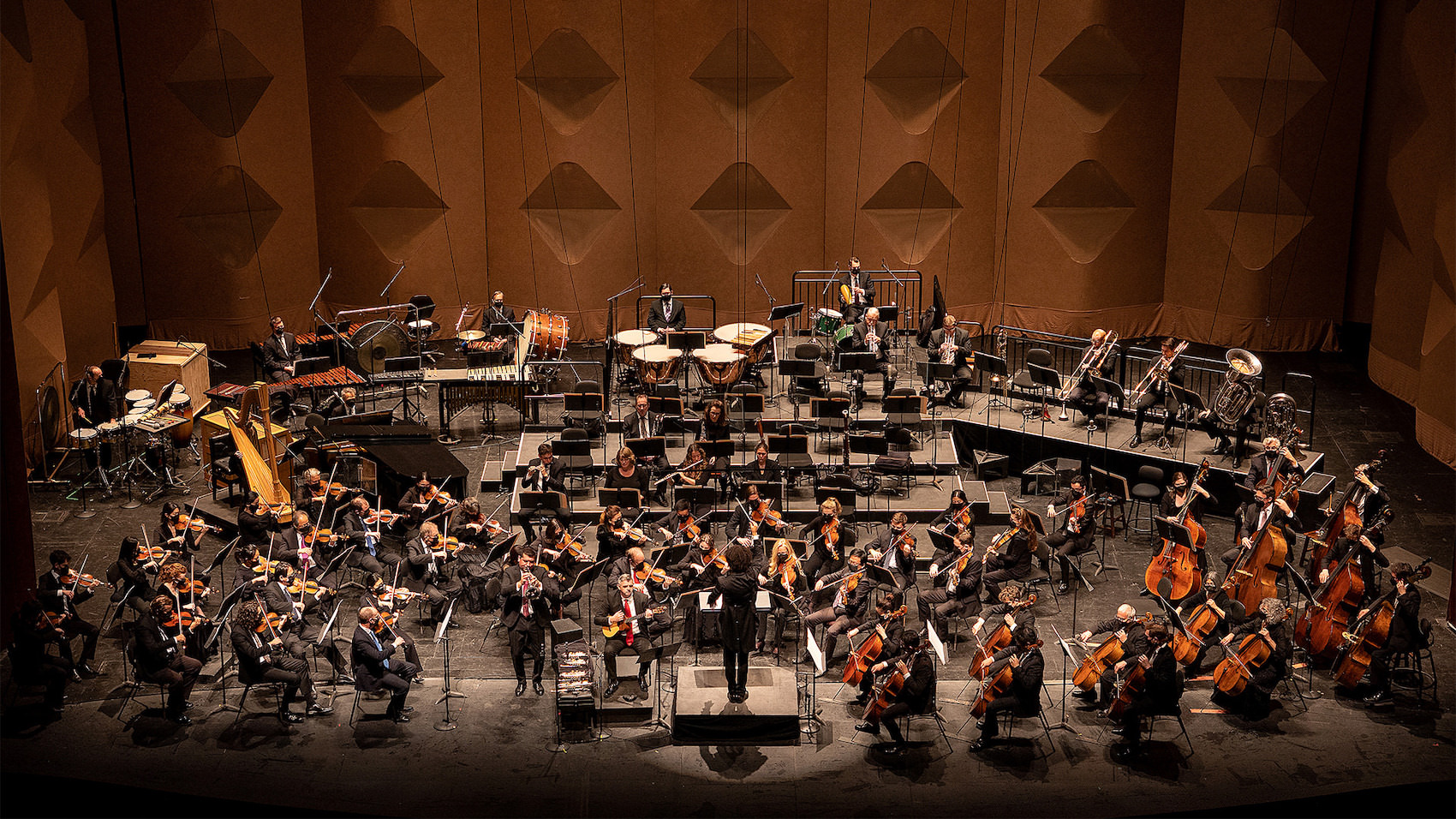Elena Schwarz, conductor
Steven Schick, conductor
Paul Huang, violin
Program:
Igor Stravinsky: Fanfare for a New Theatre
Rand Steiger: Triton’s Rise
Anna Thorvaldsdóttir: Metacosmos
Samuel Barber: Violin Concerto, Op. 14
Lei Liang: Bamboo Lights
Igor Stravinsky: Symphony in Three Movements
Celebrate the opening of the Epstein Family Amphitheater with the San Diego Symphony.
The San Diego Symphony and UC San Diego musicians will be featured on the opening concert of the Epstein Family Amphitheater at 7:30 pm on October 21, 2022. The program will begin with Stravinsky’s Music for a new Theatre for two trumpets, followed by the premiere of Triton’s Rise, composed by Professor Rand Steiger for percussion soloist Professor Steven Schick, accompanied by 16 percussionists located around the amphitheater and on the verandas of adjacent buildings. Then Schick will conduct the San Diego Symphony in a performance of Metacosmos, composed by alumnus Anna Thorvaldsdottir (originally commissioned by the New York Philharmonic). Elena Schwarz will then take to the podium to conduct Samuel Barber’s Violin Concerto featuring soloist Paul Huang, Bamboo Lights by Professor Lei Liang, and Symphony in Three Movements by Igor Stravinsky.
Insights from the San Diego Symphony Creative Consultant Gerard McBurney
Igor Stravinsky: Fanfare for a New Theatre
One of the shortest pieces ever written! Stravinsky used just two trumpets, one player on each side of the stage, for this micro-fanfare written in 1964 for the opening of the New York State Theater at the Lincoln Center for the Performing Arts in New York City.
Rand Steiger: Triton’s Rise
Rand Steiger is one of San Diego’s most fascinating and distinguished composers, working in a great variety of media from live players to purely electronic music, and with a special interest in the spatial aspect of music. That’s one reason why he was the perfect choice for this world premiere piece to celebrate the completion of UC San Diego’s amazing new Epstein Family Amphitheater.
What stunning tricks will he come up with?!?
Anna Thorvaldsdóttir: Metacosmos
The Icelandic composer Anna Thorvaldsdóttir is one of the strongest and most exciting people writing for symphonic forces in our time. Her scores have been taken up by orchestras all over the world including New York Philharmonic and the Berlin Philharmonic.
Her 14-minute orchestra piece Metacosmos is typical of her work, filled with expansive and unusual colors, with a quality half of film music, half of reaching back into a more ancient musical world, perhaps from before music was ever written down.
The composer herself writes:
Metacosmos is constructed around the natural balance between beauty and chaos… The idea and inspiration… is the speculative metaphor of falling into a black hole… with endless constellations and layers of opposing forces connecting and communicating with each other… You realize that you are being drawn into a force that is beyond your control…
Samuel Barber: Violin Concerto, Op. 14
It was not long after he completed the First Essay that Barber began his Violin Concerto, which was originally intended for a friend and fellow student at The Curtis Institute; the friend was then persuaded by his own teacher to refuse to perform the piece on the grounds that it was not enough of a show-piece for an up-and-coming star.
A show-piece in that traditional sense it certainly isn’t, but the teacher was completely wrong in that this work is now one of the best-loved violin concertos of the 20th century (and certainly among the best loved of all American violin concertos). Its first two movements are overflowing with gorgeous melodies, and the brief last movement serves as a spectacular fire-cracker which is guaranteed to make the audience leap to their feet in excitement at the end.
Like the Adagio and the First Essay, this is music shot through with melancholy and a sense of a disaster about to burst on humanity in the shape of the Second World War. And its hauntingly beautiful tunes speak eloquently of Barber’s belief in the preciousness of private, quiet and personal emotions in a time of cruelty and bombast.
But it is also, whatever that old teacher mistakenly once thought, brilliantly written for a great violinist playing a great instrument, all the violin’s rich singing colors wonderfully interwoven with the sounds of the orchestra. Look out especially for the terrific oboe melody in the second movement which the soloist then takes over and magically transforms.
Barber began this concerto while staying in the spectacular mountains of Switzerland, but as war approached, American citizens were advised to leave Europe and return to the USA, which Barber did. After a short stay with his family, to finish the piece, he found a quiet place to work in the Pocono Mountains of Pennsylvania.
This is indeed a concerto composed in two very different mountain landscapes!
Lei Liang: Bamboo Lights
Lei Liang is a strikingly inventive Chinese-born composer who came to the United States at the age of 18, and with his rich outpouring of compositions has become an important part of modern American music, with an international reputation. He lives and works right here in San Diego, where he is the Chancellor’s Distinguished Professor of Music at the University of California, San Diego.
In his works, which range across many different forms, Lei Liang often draws from and weaves together his Chinese and American experiences and memories from his Chinese childhood. And so it is here. Bamboo Lights, a short chamber-orchestral piece from 2013, is – says the composer – a memorial to members of his family who died in the course of World War II. The composer himself writes:
“Dense bamboo forests surround and shelter the villages in southern China. Those groves bore witness to the horrors and atrocities of war: howling winds, flickering lights, eyes, shining, gazing, peering through the leaves…”
Igor Stravinsky: Symphony in Three Movements
Igor Stravinsky was a lifelong migrant. He grew up in Russia, lived the central 25 years of his life in Switzerland and France, and then – with the mounting threat of war in Europe – he and his second wife Vera emigrated to the USA in 1939, settling eventually in Los Angeles, where they became American citizens at the very end of 1945. And in the last period of his life, he divided his time between New York and Europe, especially Switzerland and the city of Venice, where he chose to be buried next to his long-ago patron and friend, Serge Diaghilev.
The composer’s Symphony in Three Movements is one of the most important of several masterpieces from his Californian years. It’s a real LA symphony, and intriguingly, parts of it even use musical ideas originally planned for possible movie projects, most especially Song of Bernadette. Song of Bernadette is based on a novel about the famous French Saint Bernadette of Lourdes by the Austrian writer Franz Werfel (also, like Igor and Vera Stravinsky, a refugee living in Hollywood with his wife Alma, most famous as the widow of the composer Gustav Mahler). In the event, Stravinsky, though he had already written some music for the film, was not hired to write the score, which was given instead to Alfred Newman, who won an Oscar for his efforts. Stravinsky’s response was to reuse that music – originally intended for a scene where Saint Bernadette sees one of her 18 visions of the Virgin Mary – as part of this powerful symphony.
But this symphony has other cinematic associations, too. Usually, Stravinsky was not fond of giving non-musical explanations of his works, but he several times referred to this music as a personal response to the shocking events of World War II. His response was a result of seeing newsreel and documentary footage in the cinema of Japanese atrocities in mainland China, shots of goose-stepping soldiers in Nazi Germany, and images of Allied victories in Europe in the later part of the war. It’s clear that the composer was deeply affected by the sensation of being far from his two earlier homelands of Russia and France at such a terrible time of unspeakable violence and human suffering.
Stravinsky was no romantic. Despite the filmic and emotional origins of many of the images in this piece, this is a real piece of neo-classical purity: music of clear, bright and shimmering details. There’s nothing sentimental about it.
Another interesting detail is that while Stravinsky was composing this symphony, he was editing the score of his most famous work, his ballet The Rite of Spring (composed more than 30 years earlier), and there are exciting moments in this symphony when we hear echoes of the tremendous rhythmic eruption of that much earlier piece.






